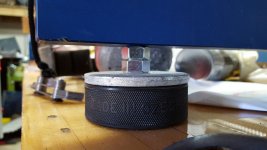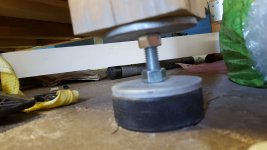You are using an out of date browser. It may not display this or other websites correctly.
You should upgrade or use an alternative browser.
You should upgrade or use an alternative browser.
Leveling CNC Router
- Thread starter conetip
- Start date
Just curious how people are leveling their cnc Router machines ?
I was thinking about leveling the rails that the X axis runs on and leveling the rail of the y axis.
Any thoughts appreciated.
Neil
I have never checked to see if it was level......... it sits on a work bench with a 3/4 in plywood top.............
maybe I should do that............
Kim
A friend of mine gave me a machinist's level. I tried to use it to level out my CNC rails. Those things will drive you batty!!! "OMG, it's 3 graduations off!!" When in fact on my level those three graduations mean 3 thousands of an inch out at 10 feet.

Gary
Gary
Hockey pucks
I can't take credit for this idea, but it's a really good one. Leveling feet, at least what I saw, are kind of expensive.
For the base table I used: 1 puck, 1 carriage bolt, 2 thick fender washers, 2 nuts, and a custom made bushing.
CNC base is same expect socket bolt instead of carriage screw and only one fender washer. I should have just used sockets for both.
Table:
1. Center drill puck and then counterbore to allow head to sit below surface of puck. You want the bolt to be able to rotate and not the puck.
2. For wood, make a simple aluminum bushing and tap it to size of puck bolt. I used 1/2...i think. If you let it float in the wood with no bushing I'm guessing it wouldn't be nearly as stable.
3. Bore wood leg interference fit with bushing, apply some epoxy, drive home.
4. One fender washer sits on top of puck and the other on top of the second nut.
You want to tighten the nuts together and turn the bolt. Then when it's level, use the top nut to cinch the assembly.
If your table, even if it's wood, is relatively flat, then you won't have to mess too much with the cnc feet.
I can't take credit for this idea, but it's a really good one. Leveling feet, at least what I saw, are kind of expensive.
For the base table I used: 1 puck, 1 carriage bolt, 2 thick fender washers, 2 nuts, and a custom made bushing.
CNC base is same expect socket bolt instead of carriage screw and only one fender washer. I should have just used sockets for both.
Table:
1. Center drill puck and then counterbore to allow head to sit below surface of puck. You want the bolt to be able to rotate and not the puck.
2. For wood, make a simple aluminum bushing and tap it to size of puck bolt. I used 1/2...i think. If you let it float in the wood with no bushing I'm guessing it wouldn't be nearly as stable.
3. Bore wood leg interference fit with bushing, apply some epoxy, drive home.
4. One fender washer sits on top of puck and the other on top of the second nut.
You want to tighten the nuts together and turn the bolt. Then when it's level, use the top nut to cinch the assembly.
If your table, even if it's wood, is relatively flat, then you won't have to mess too much with the cnc feet.
Attachments
Thanks for the replies, this machine has a 1200mm X and 600 Y cutting area.
It has the fancy leveling feet.
I'll look at what I can do to get the rails level and will post back what I find or discover.
I have a ridiculously sensitive level and a standard Starrett machine level for the approx leveling. When within 1 div of the Starrett the fine one is still off its scale.
Thanks everyone for the input.
Neil
It has the fancy leveling feet.
I'll look at what I can do to get the rails level and will post back what I find or discover.
I have a ridiculously sensitive level and a standard Starrett machine level for the approx leveling. When within 1 div of the Starrett the fine one is still off its scale.
Thanks everyone for the input.
Neil
Thanks for the replies, this machine has a 1200mm X and 600 Y cutting area.
It has the fancy leveling feet.
I'll look at what I can do to get the rails level and will post back what I find or discover.
I have a ridiculously sensitive level and a standard Starrett machine level for the approx leveling. When within 1 div of the Starrett the fine one is still off its scale.
Thanks everyone for the input.
Neil
I used the 99. I have a center bubble level that you could spend days with..
I think leveling our types of cnc's is overrated. The only real reason would be to make sure they dont rock or drift when moving. Most of the materials used "extrusion" are so inaccurate that taking the time to get the table level is pointless.
Far more important would be initial assembly. Making sure the base and linear bearings are co-planar is the most important step as it sets the stage for the intersecting axis to be set plumb and truly perpendicular. I think most people who actually take the time to sweep there bed with indicator would wish they didnt.
But, its just a pool cue machine. Usually there can be a huge discrepancy in a longer distance that will never come close to showing up when machining small stuff like inlays.
Far more important would be initial assembly. Making sure the base and linear bearings are co-planar is the most important step as it sets the stage for the intersecting axis to be set plumb and truly perpendicular. I think most people who actually take the time to sweep there bed with indicator would wish they didnt.
But, its just a pool cue machine. Usually there can be a huge discrepancy in a longer distance that will never come close to showing up when machining small stuff like inlays.
nevermind...I think leveling our types of cnc's is overrated. The only real reason would be to make sure they dont rock or drift when moving. Most of the materials used "extrusion" are so inaccurate that taking the time to get the table level is pointless.
Far more important would be initial assembly. Making sure the base and linear bearings are co-planar is the most important step as it sets the stage for the intersecting axis to be set plumb and truly perpendicular. I think most people who actually take the time to sweep there bed with indicator would wish they didnt.
But, its just a pool cue machine. Usually there can be a huge discrepancy in a longer distance that will never come close to showing up when machining small stuff like inlays.
Last edited:
Well, I leveled the rail on 1 side, then leveled the rail on the other side with the x axis in the center of the machine.
I moved the X to one end and looked at the Y level, then at the other end. Then moved one side to get it close, then to the middle and the home end.
I will recheck the machine in a few months time, and then reface the table. Very happy with it so far.
Initially I leveled off the table face, but discovered that the rails were not level. Hence my initial question.
Thanks for the input and information provided.
Neil
I moved the X to one end and looked at the Y level, then at the other end. Then moved one side to get it close, then to the middle and the home end.
I will recheck the machine in a few months time, and then reface the table. Very happy with it so far.
Initially I leveled off the table face, but discovered that the rails were not level. Hence my initial question.
Thanks for the input and information provided.
Neil


